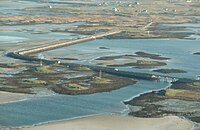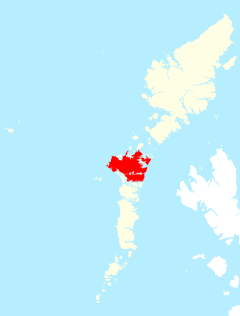North Uist
| North Uist Gaelic: Uibhist a Tuath | |
| Main village: | Lochmaddy |
|---|---|
| Location | |
| Location: | 57°36’0"N, 7°19’59"W |
| Grid reference: | NF835697 |
| Area: | 117 square miles |
| Highest point: | Eaval, 1138 feet |
| Data | |
| Population: | 1,271 |
North Uist is an island of Inverness-shire in the Outer Hebrides. At low tide it forms one long island with the main isles to the south, South Uist and between them Benbecula and Grimsay, and these are all now joined by causeways. Other, minor isles are joined to it at low tide too, amonst them Vallay and Kirkibost Island.
In the north, North Uist is joined by a causeway to Berneray. It is separated from the Isle of Harris by the Sound of Harris. Like Lewis and Harris, North Uist is staunchly Presbyterian, which sets it at odds with Roman Catholic South Uist.
Geography
North Uist is the thirteenth-largest island of those surrounding Great Britain, covering an area of 117 square miles, slightly smaller than South Uist.
North Uist is connected by causeways to Benbecula by way of Grimsay, to Berneray, and to Baleshare. With the exception of the south east, the island is very flat, and covered with a patchwork of peat bogs, low hills and lochans, so that more than half the land is covered by water. Some of the lochs contain a mixture of fresh and tidal salt water, giving rise to some complex and unusual habitats. Loch Sgadabhagh, about which it has been said "there is probably no other loch in Britain which approaches Loch Scadavay in irregularity and complexity of outline", is the largest loch by area on North Uist although Loch Obisary has about twice the volume of water.[1] The northern part of the island is part of the South Lewis, Harris and North Uist "National Scenic Area".
Villages and crafting settlements

The main village on the island is Lochmaddy, a fishing port. Here is a wee museum, an arts centre and a camera obscura. Caledonian MacBrayne ferries sail here from the village to Uig on Skye, as well as from the island of Berneray (which is connected to North Uist by road causeway), to Leverburgh in Harris. Lochmaddy also has Taigh Chearsabhagh - a museum and arts centre with a café, small shop and post office service. Nearby is the Uist Outdoor Centre.
The island's main villages are Sollas, Hosta, Tigharry, Hougharry, Paible, Grimsay and Cladach Kirkibost. Other settlements include Clachan Carinish, Knockquien, Port nan Long, Greinetobht and Scolpaig, home to the nineteenth century Scolpaig Tower folly.
According to the 2001 census North Uist had a population of 1,271 (or 1,320 including Baleshare).[2]
Places of interest
North Uist has many prehistoric structures, including the Barpa Langass chambered cairn, the Pobull Fhinn stone circle, the Fir Bhreige standing stones, the islet of Eilean Dòmhnuill (which may be the earliest crannog site in Scotland),[3] and the Baile Sear roundhouses, which were exposed by storms in January, 2005.[4]
The island has rich for its birdlife, including corncrakes, arctic terns, gannets, corn buntings and Manx shearwaters. The RSPB has a nature reserve at Balranald.[5]
Despite limited facilities, the island's athletics club (North Uist Amateur Athletics Club) has performed well at local, regional and national athletics competitions.
Name
In Donald Munro's A Description of the Western Isles of Scotland Called Hybrides of 1549, North Uist, Benbecula and South Uist are described as one island of Ywst (Uist). Starting in the south of this 'island', he described the division between South Uist and Benbecula where "the end heirof the sea enters, and cuts the countrey be ebbing and flowing through it".[6] Further north of Benbecula he described North Uist as "this countrey is called Kenehnache of Ywst, that is in Englishe, the north head of Ywst".[6]
Some have given the etymology of Uist from Old Norse meaning "west",[7] much like Westray in the Orkney Islands.[8] Another speculated derivation from Old Norse is Ivist, derived from vist meaning "an abode, dwelling, domicile".[9] "Ívist" was the name used for Uist in the Old Norse sagas.
A Gaelic etymology is also possible, with I-fheirste meaning "Crossings-island" or "Fords-island", derived from I meaning "island" and fearsad meaning "estuary, sand-bank, passage across at ebb-tide".[8][10] Place-names derived from fearsad include Fersit, and Belfast.[10]
Population
In the eighteenth century the total population of the combined Uists rose dramatically, before the population crash of the Highland Clearances. In 1755, there was an estimated combined population on the Uists, of 4,118; by 1794 it rose to 6,668; and in 1821 to 11,009.[7]
North Uist
The pre-clearance population of North Uist was about 5,000 and it has dwindled to about 1,300 people in 2001.
From Haswell-Smith (2004)[7] except as stated.
History
After the Norse occupation of the Hebrides, the MacRuairidhs controlled the island.[7] North Uist was granted to Macdonald of Sleat in 1495,[12] and remained in possession of the Macdonalds of Sleat until 1855, when it was sold to Sir John Powlett Ord.[11] Today the island is owned by the Earl Granville through the North Uist Trust.[11]
North Uist and the Clearances
North Uist was hit hard during the Highland Clearances, and there was large scale emigration from the island to Cape Breton, Nova Scotia, Canada.[13] The pre-clearance population of North Uist had been almost 5,000,[11] though by 1841 it had fallen to 3,870,[12] and has further dwindled to about 1,300 people today. The clearances occurred later on North Uist than on South Uist.[13]
The main reason for the massive scale of emigration was the failure of the island's kelp industry. Since the French Revolutionary Wars the kelp industry had been North Uist's main source of income.[13] Though with the collapse of their main source of income the crofters of North Uist could not afford the high rents.[13] Even as the landlords reduced the rents, such as in 1827 when the rents were reduced by 20%, many crofters were forced to emigrate.[13]
The first real clearances on North Uist occurred in the 1820s.[13] In 1826 the villages of Kyles Berneray, Baile Mhic Phail and Baile mhic Conon, located on the north-east corner of North Uist, were cleared of their inhabitants. Although some moved further east to Loch Portain, most of those affected moved to Cape Breton, Nova Scotia.[13] The effect of this is shown in the rental roll of 1827, which states that over fifty families had "Gone to America", meaning Cape Breton.[13] As the economic conditions worsened and with reports of islanders succeeding overseas, the numbers of families emigrating from Scotland to North America greatly increased.[13] In 1838 1,300 people from North Uist were recorded as being cleared. It is misconception that most families involved in the clearances were "cleared" from their holdings, though in 1849 there was rioting as 603 inhabitants from Sollas were forcefully cleared by Lord Macdonald.[14] In the incident the women of Sollas took large part in the rioting.[15] As a detachment of Glasgow police officers advanced on the protesters, the Sollas men were said to have stood aside, but the women of Sollas stood up to the authorities, and pelted the police with rocks. The police then descended upon the Sollas folk and attacked them with their truncheons.[16] One Hebredian settlement in Cape Breton County, Nova Scotia was originally called Sollas (now named Woodbine).[17][18] North Uist surnames affected during the clearances were the MacAulays, MacCodrums, MacCuishs, and MacDonalds.[13]
Pictures
-
Looking along the beach and machair of the spit Corran Aird a' Mhòrain.
-
Landsat image of North Uist
Outside links
- North Uist local community website
- Balranald Nature Reserve
- Taigh Chearsabhagh
- Explore North Uist
- Am Paipear Community Newspaper
References
- ↑ Murray and Pullar (1908) "Lochs of North Uist" Pages 188-89, Volume II, Part II. National Library of Scotland. Retrieved 20 December 2009.
- ↑ 2.0 2.1 "Number of residents and households in all inhabited islands" (PDF). General Register Office for Scotland. http://www.gro-scotland.gov.uk/files1/stats/occasional-paper-10-table1.pdf. Retrieved 17 October 2007. Cite error: Invalid
<ref>tag; name "occasional-paper-10-table1" defined multiple times with different content - ↑ Armit, Ian (1998). Scotland's Hidden History. Stroud, Gloucestershire: Tempus. ISBN 0-7524-1400-3.
- ↑ Ross, John (11 July 2007). "Race to study Iron Age roundhouses before they are lost to sea storms". The Scotsman. http://news.scotsman.com/scotland.cfm?id=1079032007. Retrieved 4 December 2007.
- ↑ "Wildlife and habitats of Uist". Scottish Natural Heritage. http://www.snh.org.uk/scottish/wisles/wisles.asp. Retrieved 6 January 2008.
- ↑ 6.0 6.1 "A Description of the Western Isles of Scotland Called Hybrides". Undiscovered Scotland. http://www.undiscoveredscotland.co.uk/usebooks/monro-westernislands/index.html. Retrieved 31 October 2007.
- ↑ 7.0 7.1 7.2 7.3 Haswell-Smith, Hamish (2004). The Scottish Islands. Edinburgh: Canongate. ISBN 1841954543.
- ↑ 8.0 8.1 Thomas, F. W. L.. "Did the Northmen extirpate the Celtic Inhabitants of the Hebrides in the Ninth Century?". Proc. Soc. of Antiq. Scot 11: 475–476.
- ↑ Cleasby, Richard and Vigfusson, Gudbrand (1874). "An Icelandic-English dictionary". Germanic Lexicon Project. p. 711. http://lexicon.ff.cuni.cz/png/oi_cleasbyvigfusson/b0711.png. Retrieved 6 January 2008.
- ↑ 10.0 10.1 fearsaideag "An Etymological Dictionary of the Gaelic Language". http://www.ceantar.org/Dicts/MB2/mb17.html#fearsaideag fearsaideag. Retrieved 31 October 2007.
- ↑ 11.0 11.1 11.2 11.3 Hebridean Princess Scotland Retrieved on 17 October 2007
- ↑ 12.0 12.1 North Uist (Uibhist a Tuath) Retrieved on 14 October 2007
- ↑ 13.00 13.01 13.02 13.03 13.04 13.05 13.06 13.07 13.08 13.09 Lawson, Bill. "From The Outer Hebrides to Cape Breton - Part II". The Global Gazette. 10 September 1999. Retrieved on 14 October 2007
- ↑ History of Scotland The Highland Clearances Retrieved on 16 October 2007
- ↑ Island Fling, September, 2002. Vancouver Island Scottish Country Dance Society. Retrieved on 17 October 2007
- ↑ MacQuarrie, Brian. "In search of Scottish roots". Boston Globe Retrieved on 17 October 2007
- ↑ Turas Rannsachaidh dha 'n Albainn: Research Trip to Gaelic Scotland Retrieved on 16 October 2007
- ↑ Places in Cape Breton County, Nova Scotia Retrieved on 16 October 2007
Books
- Johnson, Alison(1989) Islands in the Sound: Wildlife in the Hebrides: London; Victor Gollancz ISBN 0-575-04640-6
- Monro, Sir Donald (1549) A Description Of The Western Isles of Scotland. Appin Regiment/Appin Historical Society. Retrieved 3 March 2007. First published in 1774.
- Murray, Sir John and Pullar, Laurence (1908) Bathymetrical Survey of the Fresh-Water Lochs of Scotland, 1897-1909. London; Royal Geographical Society.


